The ultimate Aussie road trip for oyster lovers
By Riley Wilson
Beneath the star-studded sky of Tasmania’s east coast, I sit in a coastal paddock alongside a burning pile of logs and talk to the oyster in my hand. Its journey as a living, breathing, closed entity is about to end. Soon, it will cross over the proverbial pearly gates into its next life as a palate-shattering flavour sensation.
But first, I’ve got to get it open. I’ve done this dance now 15 times as I’ve made my way through the two dozen oysters I picked up from a St Helens oyster farm, Lease 65, up the road, and the rhythm is the whole thing. We’re dancing, these oysters and I. I balance the craggy, sharp-edged mollusc on a tea towel on my knee and take a deep breath. I’ve become convinced that effectively measured breathing is key to this dance.
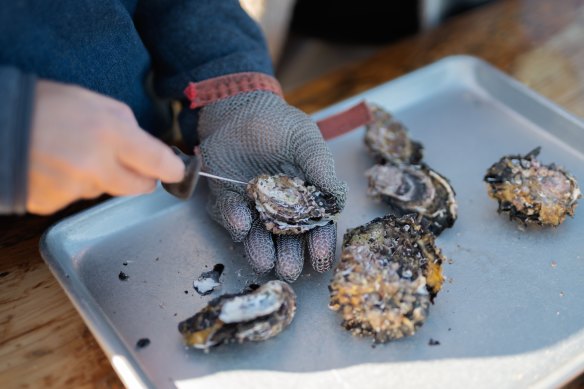
Shucked and eaten – the freshest of oysters at Melshell.
My timber-handled oyster knife has travelled down to Tasmania with me in the tub of my truck, whipped out when the stars align and I find myself happily staring at the entrance to another oyster farmgate (I didn’t have to use it at Bruny Island’s Get Shucked, however, where I sat overlooking Great Bay while slurping punchy Pacific Oysters from peach-tinted shells, or at Freycinet Marine Farm, inside the epic eponymous national park, while devouring shucked beauties alongside a bowl of Tasmanian mussels – but you get the idea.)
“Thank you for your service,” I whisper to the oyster, as the fire crackles in competition with the crashing waves. I slide the knife into the oyster’s hinge and wiggle with intention. The hinge gives way, I slice the adductor and the chilly, briny liquor spills over onto my hand. Not that I can feel the chilliness; it’s winter, and it’s almost freezing.
This moment, this scene, is almost the entire purpose of my trip to Tasmania, a mecca for the bivalve devotee. I’ve anchored myself in a small hamlet on the east coast that’s within an easy drive to fishing port St Helens on one end and beachy Bicheno at the other, all the better to seek out the molluscs that set my heart on fire.
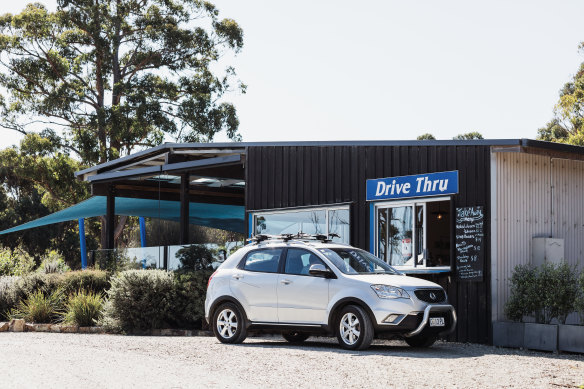
Drive-thru oysters at Bruny Island’s Get Shucked.Credit: Adam Gibson
There’s something in the water down here in Tasmania, hidden in plain sight. Beneath the blisteringly cold waves of the surrounding Tasman Sea and Indian Ocean lie millions of gorgeous, nutrient-rich, oceanic orbs of wonder.
These oysters are world-leading, with flavour profiles that mirror the waterways in which they’re nurtured. Tasmania’s aquaculture industry produces more than 3 million dozen oysters across 44 growing operations each year. It’s a highly responsive and innovative industry because it’s had to be. In 2016, a Pacific Oyster Mortality Syndrome (POMS) outbreak devastated the region, causing mass mortality and losses in excess of 5 million dozen oysters.
Melshell Oysters, down in Dolphin Sands near Swansea on Tasmania’s mid-east coast, was one of the few leases not to be affected by POMS. Run by second-generation oyster farmers Ian and Cassie Melrose, who live on the farm with their two children, the operation is compact, efficient and full of heart.
A few days after the fireside oyster chat, I pull up to Melshell’s signature pastel blue caravan. The retail operation is book-ended by the car park on one side and the oyster-sorting shed on the other. Cassie greets me with a smile and a hug, like an old friend. At the nearby processing room, two slick-and-quick shuckers grin and lift their eyebrows in recognition as they deftly flip oysters out of their shells and make these barnacled beauties look presentable.
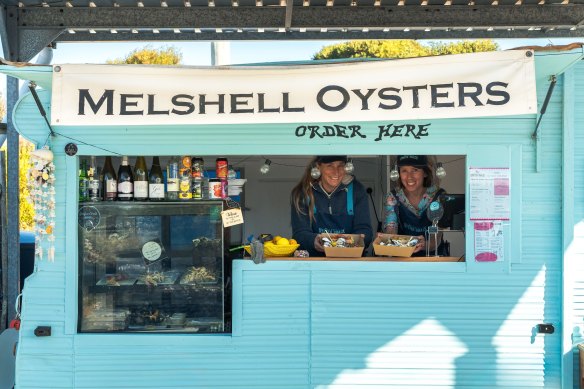
It’s the oysters’ time in the Great Oyster Bay deep that cements their signature creaminess.Credit: Oscar Sloane
Oyster farming is an art, and an exercise in patience and flexibility. Melshell oysters start their lives in the “gym” of Moulting Lagoon, with its changing water dynamics and tides, and then are finished six metres under the waterline in Great Oyster Bay, where they feast on “an all-day buffet”, as Cassie puts it, that cements their signature oceanic creaminess.
Cassie and I head to the back of the property, where the oyster-sorting sheds are, and she hands me a juvenile oyster whose rapidly growing body is – right now, at three months old – no larger than my pinky fingernail. Unlike the sun-bleached skeletons making up the footpath and breakwalls in the eating area, this one’s shell is gilded with an orange tinge.
These oysters, now known as the Melshell Gold, were a happy accident: a naturally occurring quirk of these waterways that the Melrose team decided to breed out and capitalise on. The Gold, called such to differentiate from the traditionally coloured oysters known as Silver, are buttery, smooth, in high demand and now sold at Melbourne’s Queen Victoria Market. In the shed, a huge conveyor-belt sorting system separates two-year-old oysters based on size and colour, organising 180 oysters a minute into trays and hessian bags.
The Silver sit on the back of Crackerjack, Cassie and Ian’s flat oyster barge, as it pulls into the yard behind a John Deere tractor. Ian, in rubber boats and high vis almost as bright as his smile, jumps off the back with three oysters in hand. He shucks the black-and-purple gems and I eat oysters as fresh as you can get beyond wading in the bay.
“Keep ’em deep,” Ian says. That’s the secret to their perfect finish, and to keeping them happy and healthy. “Well, I can’t really say ‘happy,’” he grins. “They don’t have a central nervous system.”
They’re transcendent: deeply salty, bright and snappy, with a rich lingering creaminess. It’s a wonder many Australians think of oysters as a summer snack, Cassie and Ian muse. Winter is when they really come into their own.
“It’s a completely different physique in winter,” Cassie says. “They’re chunky and chewy and the oyster doesn’t just disappear in your mouth.”
Cars pull up here from 10am, locals making space on ute trays to fit a few dozen and visitors clambering out of rented cars to huddle around Cassie’s blue “shack” before picking their bounty. Visitors clutch a dozen (or two) raw, cooked oysters or even oyster pate (only available here on site) as they navigate piles of oyster shells to sit in the shade of a painted-tile art installation created by 59 children from Swansea Primary School.
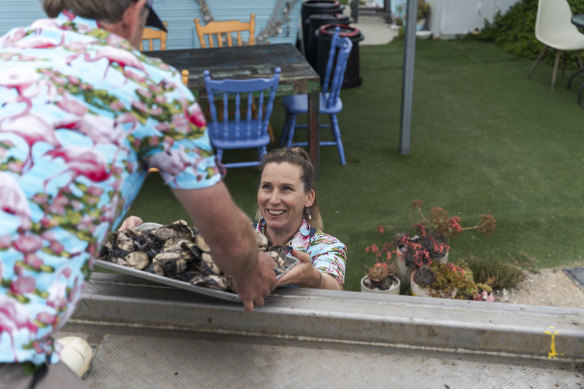
This year marks 40 years of Melshell Oysters.Credit: Tourism Australia
Forty years ago, Ian and his parents – Anne and Don, a swimming teacher and a chemist with no prior knowledge of oyster-farming, who still now, in their 90s, help seed oysters – moved to Dolphin Sands and committed to an aquaculture product they loved. Ian and Cassie keep the operation small (and fun) to share that love with everyone: visitors, suppliers, the community and their family.
“We’re growing a product that’s really healthy for everybody and the environment,” says Cassie. “The oysters are sequestering carbon [and] filtering water; we don’t have to feed them. If they’re too small, they just go back and grow.”
This year marks 40 years and two successful generations of Melshell Oysters, so Cassie and Ian threw a party right here by the water. Soon, they’ll begin building two two-bedroom bungalows for visitors to settle in and stay on site, offering classes and behind-the-scenes experiences only possible on a working oyster farm. They grin as they talk about the shindig’s schedule of Kilpatrick skewers, crumbed oysters in Po Boy-style rolls, oyster pate, billowing bonfires and local musical talents. It was also a homage to World Oyster Day, on August 5.
Cassie’s smile breaks out across her face as she turns to Ian. “That’s worth shell-ebrating.”
But the pair prove that every day down here is worth celebrating. These bivalve gems continue to survive against great odds, managing changing tides and the slightest fluctuations in water temperatures, filtering the ocean’s great gunk and becoming pure oceanic magic in the process.
Tasmania is rife with plenty of magnificent places to enjoy them, run by people who care deeply about what they’re doing and why, so I bundle back into the truck with half a dozen for the road – Cassie insists, of course – and head towards to the next farmgate, shucking knife and tea towel at the ready in the Esky on the backseat. Tasmania is, after all, my oyster.
The details
Visit
Melshell Oyster Shack is at 9 Yellow Sandbanks Road, Dolphin Sands – a two-hour drive from Hobart Airport and an hour-and-a-half drive from Launceston Airport. You’ll find other oyster farms on the east and southern coasts. Just start driving. See melshelloysters.com.au
Stay
If sticking around in the area, pull up at Swansea Beach Chalets for immaculate cabins and exemplary service. Studios from $160 a night. See swanseachalets.com.au
Fly
Qantas, Virgin and Jetstar fly to Hobart and Launceston.
Tasmanian oysters: The hit list
Barilla Bay Oysters, Cambridge
Just 15 minutes out of downtown Hobart and five minutes from the airport’s landing strip, Barilla Bay Oysters offers serious bang for your buck. A dozen shucked oysters will set you back only $16. These milky, delicately flavoured oysters are the perfect eating size and hold up well to a slice of lemon or vinaigrette. There’s also a restaurant with views out over the lease. See barillabay.com.au
Lease 65, St Helens
Purely open for oyster sales, this no-frills, cash-only operation delivers seamlessly delicious, full-bodied oysters from Monday to Friday. Peel out of St Helens and down Binalong Bay Road, with an eye for the tiny strip of gravel parking along the road. Available live, shucked or frozen, Lease 65 oysters are meaty, salty and full of bite (no website; and if they’re shut, you’ll get the oysters at the fish shops at St Helens port).
Freycinet Marine Farm, Freycinet Peninsula
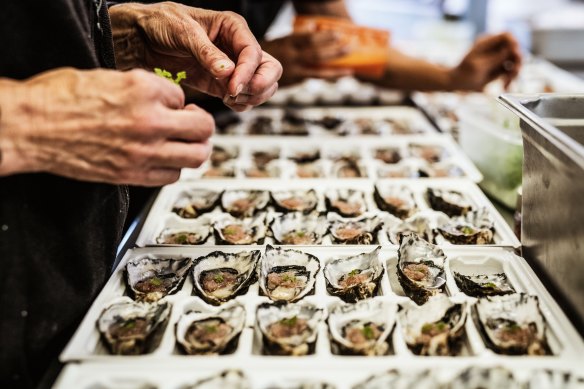
Freycinet Marine Farm, inside the epic eponymous national park, offers some of the state’s best seafood.Credit: Stu Gibson
A jaunt through Tasmania’s most visited national park, Freycinet, is not complete without lunch at Freycinet Marine Farm, home to succulent Pacific oysters and Tasmanian blue mussels. The family-run operation offers farm tours (don those waders), too. See freycinetmarinefarm.com
Melshell Oysters, Dolphin Sands
Sparky, fun and full of life, you’ll know you’ve made it to the family-run oyster operation after driving down Dolphin Sands Road and seeing a roadside sign. Turn off, go a bit further and try not to smile at the blue caravan awaiting your arrival. Enjoy a glass of sparkling with your creamy dozen oysters as you look out over the very waters they were grown in. See melshelloysters.com.au
Get Shucked, Bruny Island
An oyster-lover’s paradise. Either pick up oysters at the drive-through window, or perch yourself on the patio overlooking the water and stay awhile. Oysters are shucked and delivered, so you can sip on champagne in the sunshine while downing oysters farmed directly across the road. See getshucked.com.au
Stillwater, Launceston
Fine-dining institution Stillwater is located on the site of an old flour mill. Settle in for a two- or three-course feast, but be sure to add an oyster service. Its oysters come from north-west Tasmania and are served simply shucked on stones. See stillwater.com.au
Bar Wa, Hobart
North Hobart izakaya-style Bar Wa is known for its oyster happy hour – all oysters are half-price when you buy a beverage. They source from across the state, so ask where today’s oysters are from and then enjoy them raw with a zesty granita or Kilpatrick-style with tiny bites of pork belly while people-watching from a streetside bar-stool. See barwaizakaya.com
Tarkine Fresh Oysters, Smithton
This oyster farm on the rugged north-west coast leans on more than 40 years of experience to turn out consistently clean, crisp and creamy oysters. You’ll find them in restaurants from Stanley to Launceston, but venture to the farmgate for a 30- or 60-minute farm tour. See tarkinefreshoysters.com.au
The writer travelled at her own expense.
Sign up for the Traveller Deals newsletter
Get exclusive travel deals delivered straight to your inbox. Sign up now.